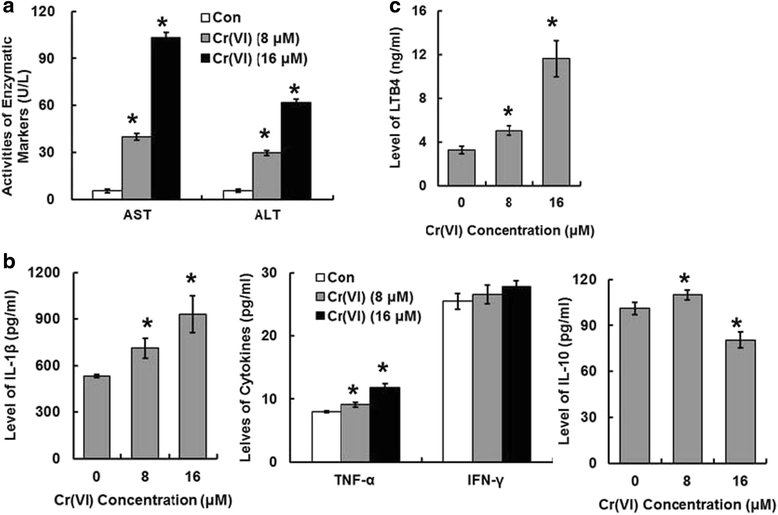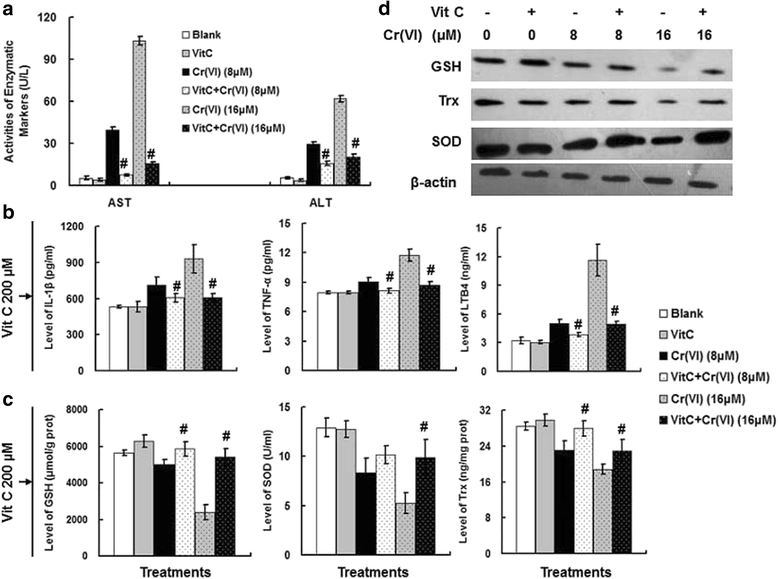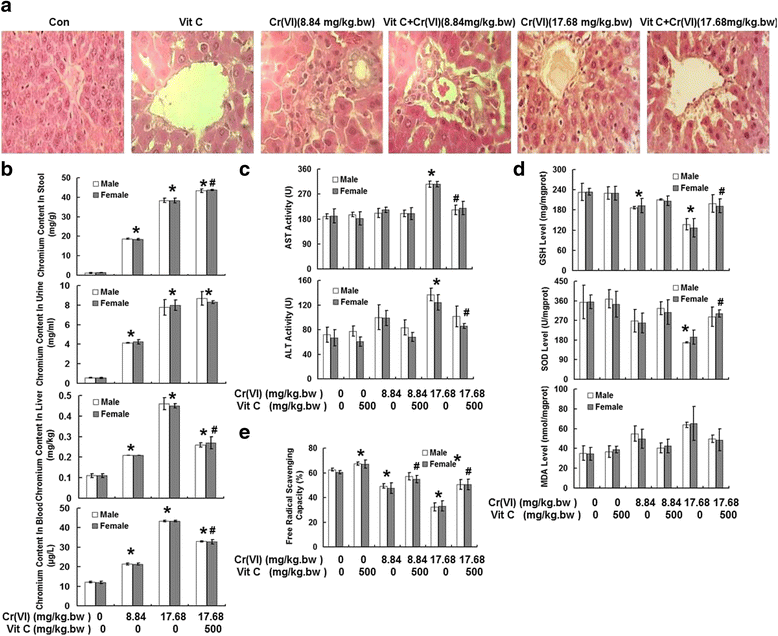An evaluation of the protective role of vitamin C in reactive oxygen species-induced hepatotoxicity due to hexavalent chromium in vitro and in vivo
- PMID: 28638434
- PMCID: PMC5472873
- DOI: 10.1186/s12995-017-0161-x
An evaluation of the protective role of vitamin C in reactive oxygen species-induced hepatotoxicity due to hexavalent chromium in vitro and in vivo
Abstract
Backgroud: Drinking water contamination with hexavalent chromium [Cr (VI)] has become one of the most serious public health problems, thus the investigation of Cr (VI)-induced hepatotoxicity has attracted much attention in recent years.
Methods: In the present study, by determining the indices of hepatotoxicity induced by Cr (VI), the source of accumulated reactive oxygen species (ROS), and the protective effect of the antioxidant Vitamin C (Vit C), we explored the mechanisms involved in Cr (VI)-induced hepatotoxicity in vitro and in vivo.
Results: We found Cr (VI) caused hepatotoxicity characterized by the alterations of several enzymatic and cytokine markers including aspartate aminotransferase (AST), alanine aminotransferase (ALT), interleukine-1β (IL-1β), and tumor necrosis factor-α (TNF-α), etc. ROS production after Cr (VI) exposure was origins from the inhibition of electron transfer chain (ETC) and antioxidant system. Vit C inhibited ROS accumulation thus protected against Cr (VI)-induced hepatotoxicity in L-02 hepatocytes and in the rat model.
Conclusions: We concluded that ROS played a role in Cr (VI)-induced hepatotoxicity and Vit C exhibited protective effect. Our current data provides important clues for studying the mechanisms involved in Cr (VI)-induced liver injury, and may be of great help to develop therapeutic strategies for prevention and treatment of liver diseases involving ROS accumulation for occupational exposure population.
Keywords: Hepatotoxicity; Hexavalent chromium [Cr (VI)]; Mitochondrial respiratory chain complex I (MRCC I); Reactive oxygen species (ROS); Vitamin C (Vit C).
Figures






Similar articles
-
Role of mitochondrial electron transport chain dysfunction in Cr(VI)-induced cytotoxicity in L-02 hepatocytes.Cell Physiol Biochem. 2014;33(4):1013-25. doi: 10.1159/000358672. Epub 2014 Apr 4. Cell Physiol Biochem. 2014. PMID: 24732427
-
Time‑order effects of vitamin C on hexavalent chromium‑induced mitochondrial damage and DNA‑protein crosslinks in cultured rat peripheral blood lymphocytes.Mol Med Rep. 2013 Jul;8(1):53-60. doi: 10.3892/mmr.2013.1462. Epub 2013 May 8. Mol Med Rep. 2013. PMID: 23657841
-
Clusterin increases mitochondrial respiratory chain complex I activity and protects against hexavalent chromium-induced cytotoxicity in L-02 hepatocytes.Toxicol Res (Camb). 2018 Nov 15;8(1):15-24. doi: 10.1039/c8tx00231b. eCollection 2019 Jan 1. Toxicol Res (Camb). 2018. PMID: 30713657 Free PMC article.
-
Hexavalent-Chromium-Induced Oxidative Stress and the Protective Role of Antioxidants against Cellular Toxicity.Antioxidants (Basel). 2022 Nov 30;11(12):2375. doi: 10.3390/antiox11122375. Antioxidants (Basel). 2022. PMID: 36552581 Free PMC article. Review.
-
Bacterial chromate reductase, a potential enzyme for bioremediation of hexavalent chromium: a review.J Environ Manage. 2014 Dec 15;146:383-399. doi: 10.1016/j.jenvman.2014.07.014. Epub 2014 Sep 8. J Environ Manage. 2014. PMID: 25199606 Review.
Cited by
-
Potential Health Impacts, Treatments, and Countermeasures of Martian Dust on Future Human Space Exploration.Geohealth. 2025 Feb 12;9(2):e2024GH001213. doi: 10.1029/2024GH001213. eCollection 2025 Feb. Geohealth. 2025. PMID: 39944899 Free PMC article. Review.
-
Determination of interest in vitamin use during COVID-19 pandemic using Google Trends data: Infodemiology study.Nutrition. 2021 May;85:111138. doi: 10.1016/j.nut.2020.111138. Epub 2021 Jan 10. Nutrition. 2021. PMID: 33578243 Free PMC article.
-
The role of IP3R-SOCCs in Cr(vi)-induced cytosolic Ca2+ overload and apoptosis in L-02 hepatocytes.Toxicol Res (Camb). 2018 Apr 26;7(3):521-528. doi: 10.1039/c8tx00029h. eCollection 2018 May 8. Toxicol Res (Camb). 2018. PMID: 30090602 Free PMC article.
-
Transcriptomic analysis reveals particulate hexavalent chromium regulates key inflammatory pathways in human lung fibroblasts as a possible mechanism of carcinogenesis.Toxicol Appl Pharmacol. 2024 Apr;485:116889. doi: 10.1016/j.taap.2024.116889. Epub 2024 Mar 11. Toxicol Appl Pharmacol. 2024. PMID: 38479592 Free PMC article.
-
Protective effect of vitamin C against thiamethoxam-induced toxicity in male rats.Open Vet J. 2023 Oct;13(10):1334-1345. doi: 10.5455/OVJ.2023.v13.i10.13. Epub 2023 Oct 31. Open Vet J. 2023. PMID: 38027408 Free PMC article.
References
LinkOut - more resources
Full Text Sources
Other Literature Sources

